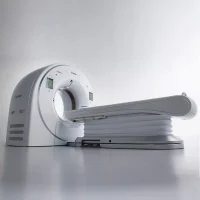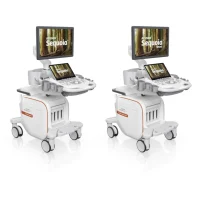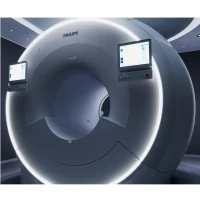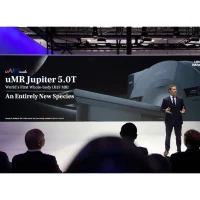- Featured presentations include development compound gadoquatrane, a novel contrast agent for MRI
- Further research explores potential of AI and digital advances in medical imaging
Bayer announced that new data from the company’s advanced radiology portfolio will be presented at the 2023 European Congress of Radiology (ECR), taking place from March 1-5 in Vienna, Austria. The presentations reflect Bayer’s commitment as a leading company in key radiology areas to accelerate innovation for the benefit of patients and their physicians, including leveraging the vast potential of artificial intelligence (AI).
A key presentation highlights new clinical data on the novel development compound gadoquatrane, a next generation macrocyclic gadolinium-based contrast agent (GBCA) which is currently in Phase II of clinical development and planned to enter Phase III later this year. Gadoquatrane features high stability as well as high relaxivity, which is a key property for use in contrast-enhanced magnetic resonance imaging (MRI). High relaxivity has in general the potential to enable a substantially lower gadolinium (Gd) dose. The study investigated the dose-response of gadoquatrane compared to a standard dose of gadobutrol, a well-established macrocyclic GBCA.
Potential ways to reduce the contrast media dose with the sharper injection bolus profile from the MEDRADTM Centargo CT Injection System, the latest addition to Bayer’s computed tomography portfolio designed to simplify radiology workflows, are the focus of another presentation at ECR.
Bayer’s research and development projects to be presented at ECR also include the topic of artificial intelligence and digital tools and how to leverage their vast potential in medical imaging. One of Bayer’s featured presentations focuses on the potential value of a learning algorithm in liver imaging, a key diagnostic area for Bayer’s radiology team. The presence of AI in radiology has grown quickly with over 200 AI applications having received a CE mark for the European market so far. While the potential for AI in radiology continues to be realized, the confidence in selecting the best applications and implementing them remains in question. Against this background, another presentation explores available publications evaluating the real-world performance of AI applications to help radiologists and their teams with insights for their clinical practice.
These research and development activities to be presented at ECR showcase Bayer’s advanced position in digital and AI powered medical imaging, bolstered by the recent acquisition of the global strategic imaging AI platform and solutions provider Blackford Analysis as well as the recent launch of CalanticTM Digital Solutions – a new platform delivering access to digital applications, including artificial intelligence enabled programs, for medical imaging. On the occasion of ECR 2023, Bayer will announce that it will partner with app developers Mediaire, Coreline, and ScreenPoint Medical to strategically expand the offering on Calantic Digital Solutions. With these new collaboration agreements, Bayer is broadening the already available options on the platform by including tools which aim to aid in neuro, cardiac and breast imaging.
Notable data to be presented by Bayer at the meeting and additional information about the topics are listed below. More information on the ECR program can be found here.
Gadoquatrane
- A randomized, 4 x 4 cross-over study to investigate the dose-response of the new high relaxivity GBCA gadoquatrane in comparison to the standard dose of gadobutrol
- This dose-response MRI study investigated the signal enhancement properties as well as pharmacokinetics and safety of the novel tetrameric macrocyclic GBCA gadoquatrane at various dose levels.
- Gadoquatrane showed a positive benefit-risk profile and was well tolerated with no apparent difference in incidence of treatment emergent adverse events with increasing doses or compared to gadobutrol.
AI- and digital-focused research
- The use of artificial intelligence to aid identification of intracerebral hemorrhage and large vessel occlusion: a systematic review
- This systematic literature review and meta-analysis seeks to identify publications that evaluated the real-world performance of AI applications and compare the results to the clinical validation performance. The focus is on AI applications indicated to rapidly identify intracranial hemorrhage (ICH) or large vessel occlusion (LVO).
- The findings from this review offer a perspective for comparison between clinical validation studies and real-world performance, offering some confidence that data from clinical validation studies will translate to real-world settings.
- Time series clustering of Primovist MRI signal enhancement
- After intravenous injection, the liver-specific MRI contrast agent Primovist distributes into the vascular and extravascular spaces and progressively into the hepatocytes and bile ducts. This happens at phases referred to as dynamic and hepatobiliary phase.
- This early research study investigated which characteristic phases an unsupervised learning algorithm applied the Signal Enhancement time curves discovers.
Centargo/Contrast media dose reduction
- A previously unknown factor of contrast media injections enables potential for dose reduction in CT: a phantom and animal study
- This early research study assessed the impact of differences in injected bolus profiles on vascular and parenchymal enhancement.
- Two injection systems with identical programmed injections (the same contrast media volume and flow rate) show differences in actual injected bolus profile due to differences in fluid delivery technology. This resulted in differences in both vascular and parenchymal peak attenuation.
- Sharper injected bolus profiles resulted in equivalent peak attenuation with a notable reduction in administered contrast agent doses.
- Personalized scan protocols for CT angiography: an experimental study for contrast media or radiation dose optimization
- For personalized medicine in radiology, particularly in computed tomography, individualized scan and contrast protocols are required.
- This early research indicated a potential reduction in contrast agent dose or radiation dose for thoracoabdominal CTA can be achieved using automated tube voltage selection systems (ATVS) while maintaining objective and subjective image quality.
- The study was performed in cooperation with Bayer AG.
Further Research
- Longterm evaluation of Gd presence in the skin and intraepidermal nerve fiber density in rats after multiple administrations of gadolinium-based contrast agents
- Gadolinium presence in the body after repeated administration of GBCAs has triggered intensive non-clinical research.
- While most studies focused on Gd presence in brain, the current study evaluated the skin of animal foot pads for Gd presence and neuro-histological changes after multiple GBCA exposure.
- No signs for small fiber neuropathy in the skin of the foot pads were observed.
In addition, Bayer’s Radiology team will present the launch of the MEDRADTM MRXperion MR Multi-Patient Disposable Kit, which can be utilized for multiple patients for up to 24 hours. The Multi-Patient Kit provides customers with the option to reduce time to change and refill syringes in between patients, thereby improving efficiency, lowering per-patient costs, and reducing waste. Furthermore, the MEDRADTM Injection System MRXperion has expanded its MRI field strength compatibility (0.55T – 7T).
Source: Bayer










